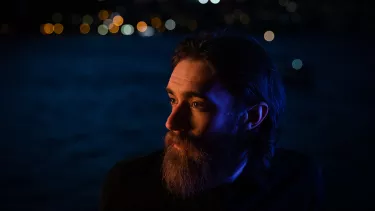Keaton Henson: What does anxiety sound like?
Celebrated folk musician Keaton Henson discusses his new orchestral work Six Lethargies, which chronicles the different stages of anxiety and trauma.
“My brain immediately registered the threat,” says Keaton Henson about the moment his music, once entirely private, was first unveiled to the world on BBC radio by Zane Lowe. Most musicians wait their whole careers for that sort of recognition, from a global tastemaker, no less.
“It realized that being too aware of all those eyes and voices would endanger my ability to make things the way I do. But what I eventually became fascinated by, which I think has culminated in Six Lethargies, was the idea that I could write something privately in my bedroom without thought of other people’s responses, and that work could not only still reach those people but it could also carry my feelings to them – these people literally on the other side of the world.”
Six Lethargies, which was performed by the Opera Australia Orchestra at Vivid LIVE 2019 and will stream as part of the Opera House's Digital Season, is the product of three years’ work and at least a decade’s worth of lingering thoughts and feelings. Henson is almost as known for his reclusive personality, of press-dodging and quietness on stage, as he is his music. Six albums under his belt, he still struggles with the unwritten expectation that he has to be both a musician and performer.
“I’ve always been baffled as to why, just because I write songs, it’s expected of me to perform in front of lots and lots of people. That’s a very specific skill and I don’t think the two have to be joined.”
Far from merely shy, Henson suffers from severe anxiety, so much so that he struggles with everyday acts like buying milk. The aim of Six Lethargies was to “dissect the issues and ailments” that have lingered throughout his career. And not just represent but to physically evoke them: “If I write how it feels to me, will it make you feel the same?” reads the show’s tagline.
As his work developed, Henson decided to turn the microscope on the audience: “I became more and more fascinated by the mechanics of emotion in music – why certain sounds I was putting in there so perfectly mirrored emotions.”
What came next was a comprehensive study of music and emotion. Henson met with neuroscientists, psychologists, music theory professors, anyone he could find. What interested him was music’s capacity as a tool for pure empathy.
“Music triggers empathy in a really direct way,” he explains. “When talking to someone or explaining how you’re feeling there are certain neural pathways that we have to go through to empathise, your brain will recount similar experiences or will use your imagination to put yourself in someone’s shoes – but music will just trigger that emotion immediately.”
...your brain will recount similar experiences or will use your imagination to put yourself in someone’s shoes – but music will just trigger that emotion immediately.
Six Lethargies is divided up into six parts, representing different chronological stages and manifestations of trauma as Henson understands them: the initial feelings that your brain is turning on you; the middle stages of anxiety; depression; and then a final moment of relief, of letting go.
The process of creating these sections was long, difficult and, by all accounts, bizarre. An illustrator as well as a musician, his workspace was covered in diagrams and “expressionistic and splattery” paintings. These would serve as abstract storyboards going forward.
As someone who balances a career as an illustrator and musician (“when one starts to drive me slowly insane I can do the other”), Henson wanted to use visual cues, as well as music, to elicit the feelings of each section. He was also unsatisfied with the visual complacency of classical shows.
“When I do venture out of my house for a concert it tends to be for classical concerts, and I get a little frustrated that they’re such willfully un-visual events. There seems to be this rule that classical concerts need to be really badly lit and very flat.”
So he consulted Brendan Walker, a scientist and ‘thrill engineer’, whose work includes designing rollercoasters, to create something of a visual experiment for his Barbican shows.
“He built software that translated the galvanic skin response data [from the Barbican audience] into the lighting data, so the audience’s anxiety levels basically ran the lighting rig.”
There seems to be this rule that classical concerts need to be really badly lit and very flat.
As the audience’s anxiety grows, so too the lighting became more anxiety-inducing, creating a feedback loop.
“The technical term would be arousal,” he clarifies. “The more elevated your physiological symptoms, the more the lighting continues to elevate them.”
The lighting created during the Barbican show has since been replicated across subsequent performances.
Henson seems to resent his reputation as broody and coy. He is forthcoming, even excitable, when talking about Lethargies.
“I think for once there’s actually something to talk about. Whereas otherwise I’m talking about a song which by definition talks about itself. With this, knowing a bit more about it helps you understand and enjoy it.”
He is conscious that the piece will be perceived as ‘brutally atonal’.
“It’s a really enjoyable evening,” he insists, describing the lingering, relaxed audience after the Barbican show, who hung around comparing notes in the courtyard.
“It is a pleasant experience, as much as I make it sound awful.”
He talks similarly about his reputation, saying that people often miss his humour: “Humour is a really important part of who I am. People think that I’m constantly miserable – but I’m not!”
Keaton Henson's Six Lethargies will be available to watch as part of the Opera House Digital Season from Friday 18th September.

